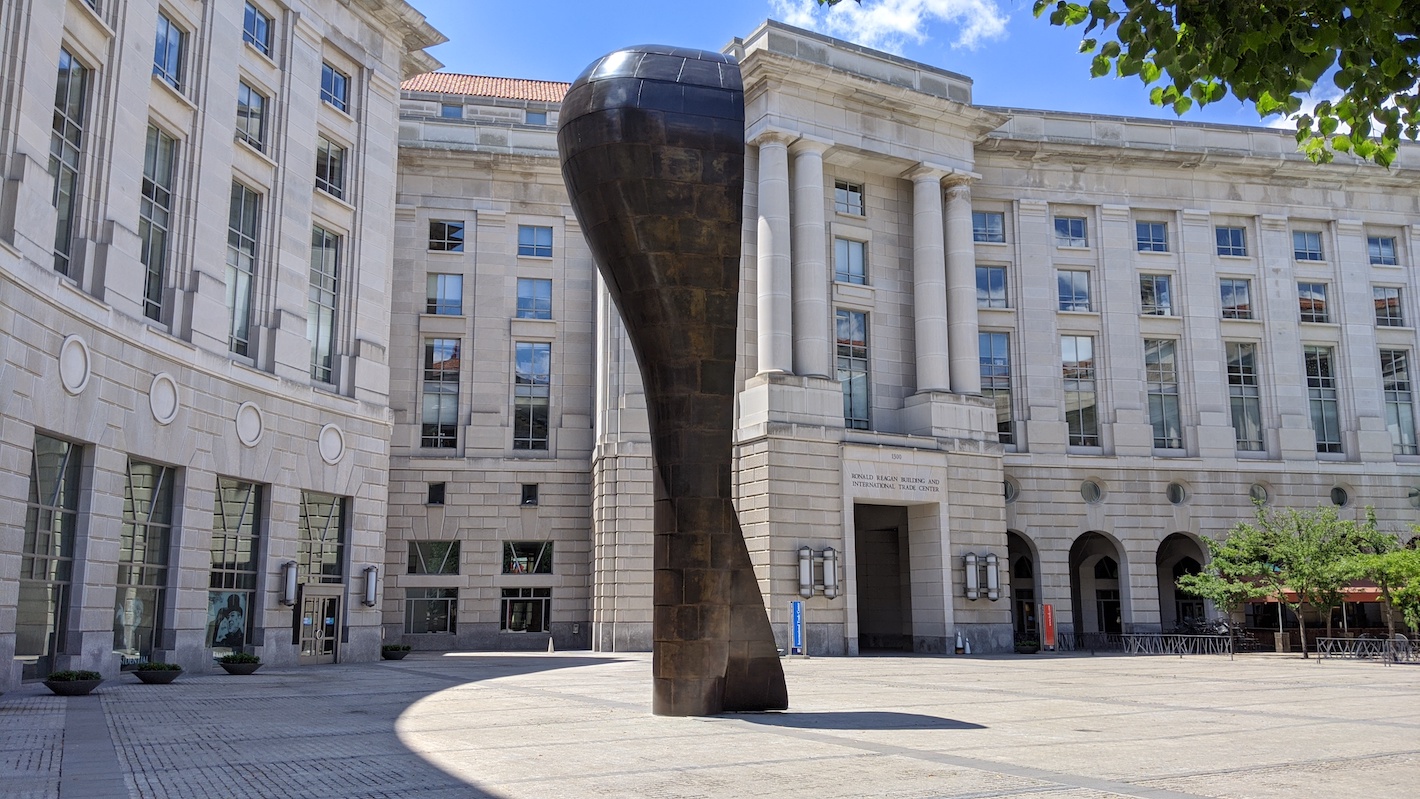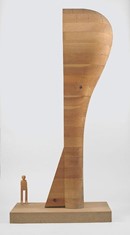
Bearing Witness
Post filed in: Art
Bearing Witness was created by world-renowned artist Martin Puryear. It is a massive sculpture, standing 40 feet tall and weighing 20,000 pounds. The exterior is covered in bronze plates that have been hammered and welded into place to produce a surface that appears handmade, despite the artwork’s colossal size and weight. The sculpture was commissioned in 1994 by GSA’s Art in Architecture program, and installed in 1997 on the Woodrow Wilson Plaza of the Ronald Reagan Building and International Trade Center in Washington, D.C.
You can see the sculpture in this short video from GSA’s Art for the People series.
Bearing Witness imposes no definitive or fixed meaning. Instead, the sculpture encourages viewers to engage it imaginatively, and to create their own meanings in response to the shape, size, material, and title of the artwork. When someone first sees this sculpture, it might call to mind all manner of objects or things. A viewer might be reminded of a giant pin, a small tool, or the rudder of a ship (in fact, the sculpture was made at a shipbuilding facility in Bristol, Rhode Island). Viewers might also recognize the silhouette of a head, since Puryear based the shape of Bearing Witness on the ceremonial wooden ngil masks historically used by the Fang people in the African nation of Gabon, as he has done with many other sculptures that share a similar shape and proportion.
For some viewers, the shape of Bearing Witness might also look like the ball of a foot, or even a giant thumb. The artwork’s warm bronze surface might resemble skin, especially when viewed against the white and gray masonry and concrete pavers that surround the sculpture. Puryear has said: “In my work, I aim for a point where organic form—or forms which suggest nature and organic processes—can coexist with forms which are clearly cultural”.
The artwork’s title also lends itself to an open-ended interpretation. Bearing Witness may equally refer to a dispassionate observer, the weight of testifying, or the more active task of pointing out the accused in court. Its placement—surrounded by government structures—certainly suggests the role of the people in holding accountable their institutions of government. Indeed, it is hard not to think of Bearing Witness as a type of sentinel, standing in for a public that watches the actions of its government. Puryear often selects titles that are, in his words, “provocative and open up possible ways for people to look at the work and think about the work rather than close it down.” In a 1998 Sculpture magazine interview, Puryear also stated: “This is one of the more challenging pieces I’ve done, because it’s in such an official public place…Its context is weighted. For myself, I wanted my work to be directed toward people rather than toward the government. In a democracy, the people talk back to the government.”
This type of imaginative engagement is a hallmark of contemporary sculpture. Like many well-conceived artworks, Bearing Witness is very good at posing questions, and is not intended to offer any clear or definitive answers. That’s one of the qualities that makes this sculpture so engaging and dynamic, and why it rewards our repeated viewing: there is always something new to notice or think about in response to Bearing Witness, based on our own accumulated life experiences.

Caption: This preliminary model, or maquette, of Bearing Witness, shows how Puryear conceived of his monumental work. His use of wood is noteworthy here, as it highlights his attention to hand-making, and indicates his desire for the full-scale artwork to retain that sense of a handmade object, despite the sculpture’s great size.
© Martin Puryear, Courtesy Matthew Marks Gallery
About the Artist
Martin Puryear was born in 1941 in Washington, D.C. He has taught at Fisk University in Nashville, the University of Maryland, and the University of Illinois. He earned a Bachelor of Arts degree in Fine Art in 1963 from the Catholic University of America in Washington, D.C., and a Master of Fine Arts degree in Sculpture in 1971 from Yale University, which also awarded Puryear an honorary doctorate in 1994. Puryear is an accomplished artist. His accolades include a fellowship from the National Endowment for the Arts in 1978, the Grand Prize at the 1989 Bienal de São Paulo, a 1989 MacArthur Foundation Fellowship, and election to the American Academy and Institute of Arts and Letters in 1992. In 2011, President Obama awarded Puryear the National Medal of Arts for his contributions as a contemporary American sculptor. Most recently, Puryear was selected to represent the United States at the 58th Venice Biennale in 2019.
To explore more of the Fine Arts Collection, please visit www.gsa.gov/fine-arts.

 U.S. General Services Administration
U.S. General Services Administration
